Kitchen Tips and Techniques: Chili | Preparing Basic Chili Ingredients | Storing Leftover Ingredients
Kitchen Tips and Techniques: Chili
- Fully develop the flavor of homemade chili by browning the meat along with the spices and onions.
- A touch of instant coffee gives chili a rich color and flavor.
- Alternate between removing and replacing the lid on the pan of chili while cooking. If the lid is left on from beginning to end of the cooking process, your chili recipes could become runny, and if the lid is left off, the chili may become too thick.
- To avoid overpowering chili, begin with a smaller amount of ingredients (i.e.: chile peppers, chile powder, garlic, etc.), allowing time for flavors to blend before adding more.
- Adding beans early in the cooking process allows them to absorb the flavor of the chili. Dark red or black kidney beans work best; they keep their shape better than light red kidney beans.
- Serve chili with bowls of accompaniments such as sour cream, grated Cheddar cheese, grated Monterey Jack cheese, herbs, and crushed tortillas.
- Leftover chili can be used on baked potatoes, hot dogs, burritos, or as a filling for omelets.
|
Preparing Basic Chili Ingredients
Tomato Paste
To easily remove tomato paste from a can: Use a can opener to open both ends of the can. Remove only one lid. Carefully push the other lid through the can with your thumbs to extract the paste. |
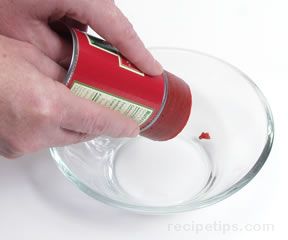 |
Preparing a Chile Pepper
When preparing hot peppers, use caution not to touch the eyes or similar areas that can be painfully affected by the capsaicin that rubs off on hands. Wearing rubber gloves is recommended as well as washing hands immediately after removing the gloves.
Begin by removing the stem and slicing the chile pepper in half. |
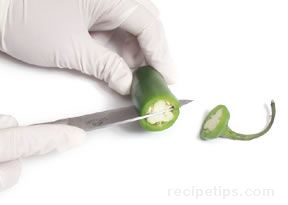 |
| With a teaspoon, carefully remove the ribs and seeds. |
 |
| The pepper can now be sliced and cooked. |
 |
Chili Powder
Chili powder is a spice blend consisting of one or two types of dried red chiles that are ground and pulverized into a powder. Common blends available in food stores typically include other ground herbs and spices such as cumin, garlic, oregano, paprika, and salt, mixed into the chili powder. Pure chili powder or ground chile is most often available from specialty spice stores and does not contain added ingredients. It consists only of ground or powdered chiles. Chili powder adds flavor and heat to ethnic dishes. When a recipe includes "chili powder" it is the common powder that is being suggested, unless it states that a specific type of chili powder, such as jalapeno chili powder or if it states ground chile.
To make your own chili powder, roast a mixture of stemmed, dried chiles (i.e. habanero, jalapeno, etc.) in a 250º oven for 20 minutes. Allow to cool. Place chiles in a blender or food processor. Process the mixture until it becomes a powder (do not breath in the fumes). The homemade chile powder can be frozen for up to 6 months in an airtight freezer bag. |
Chopping Onions
The process of chopping onions can be accomplished manually with a knife or the onions can be placed into an electric blender or food processor and chopped very quickly. Begin by (1) removing the outer layer of skin, (2) cut onion in half, (3) slice each of the onions lengthwise every 1/8" of an inch, (4) slice again in the opposite direction.

|
Garlic
- When selecting, choose garlic that is plump and firm with paper-like skins that are tight and intact. Avoid any that are soft or that have begun to shrivel.
- Place garlic cloves in the microwave for 15 seconds and the skins should peel off easily.
- Keep peeled and mince garlic fresh by placing it in a small jar and pouring just enough olive oil over it to cover the garlic and then place it in the refrigerator. It will keep its fresh flavor for about a week.
- Don't throw out sprouting garlic. Instead, plant the cloves fairly close together in a pot or in the garden (if your climate is suitable at the time). The new shoots that appear will have a mild garlic flavor and can be used in the same manner as regular chives.
|
|
Preparing Garlic
Breaking the Bulb
Begin by removing the outer layer of the garlic. With stem pointed into work surface and bulb at a slight angle, press down and away with the heal of your hand. This will break the garlic bulb into "cloves." |

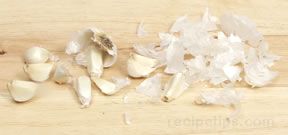 |
|
Peeling the Clove
First trim off the root end. Twist the clove between your fingers to loosen the skin. Once the skin has loosened, remove it. |
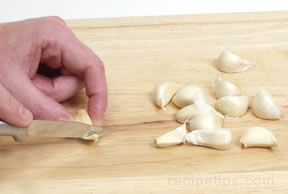 |
|
Loosening the Skin
If the garlic is fresh, loosening the skin tends to be harder.
The clove can now be cooked whole, or it can be sliced, chopped, minced, or smashed. |
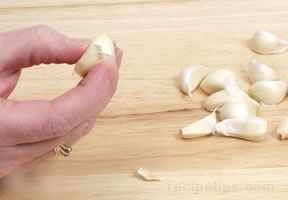
|
|
Intensity of Flavor |
|
Storing Leftover Ingredients
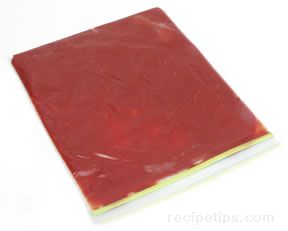 Leftover Tomato Sauce or Paste Leftover Tomato Sauce or Paste
Place unused tomato sauce or paste into an airtight freezer bag. Remove excess air by flattening the contents, seal, and freeze. When tomato paste is required for a recipe, it is easy to break off only what is needed. The remainder can be returned to the freezer for future use.
Leftover Raw Chopped Onions
Place leftover onions in an air tight container or baggy. It is imperative that the container is airtight, as onions odor becomes much stronger when chopped and the odor will affect the taste of other foods that are in your refrigerator. Refrigerate for up to one week. Raw and sautéed onions can be frozen for up to 3 months.
Leftover Garlic Cloves
After the garlic has been broken from the bulb, store in a cool, dark place. It will keep for 3 to 10 days. | |












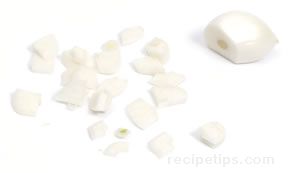
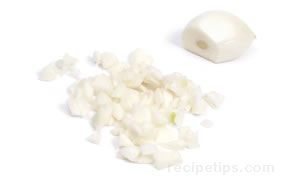
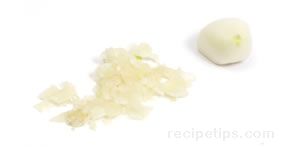
 Leftover Tomato Sauce or Paste
Leftover Tomato Sauce or Paste